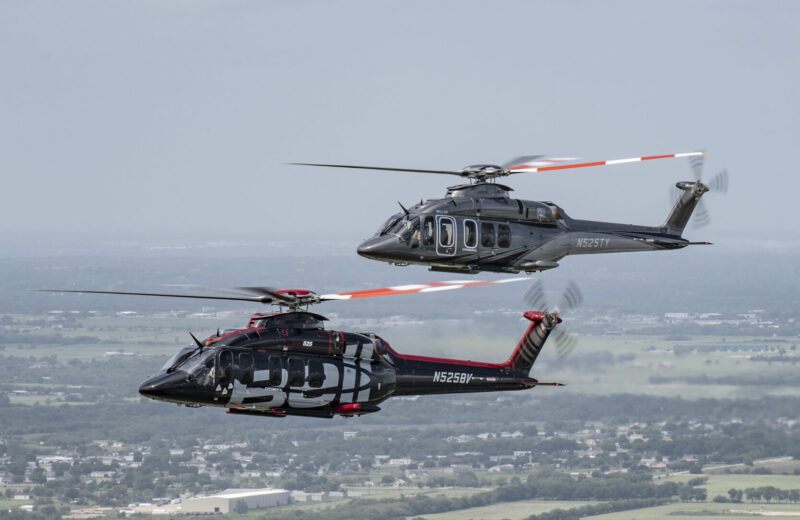THE BELL 525 RELENTLESS PREPARES FOR COMMERCIAL TAKE OFF: HI UPLIFT
Article reposted from Helicopter Investor | Written by Mike Stones

The new Bell 525 Relentless carries a heroic enough name. But it has also been a long time coming. Unveiled at the 2012 Heli-Expo Dallas, Texas, the Bell 525 first flew on July 1st, 2015. Targeting the super-medium category, it’s designed to transport up to 20 passengers or a useful load of 8,200lbs (3,700kg). Powered by two General Electric CT7-2F1 turboshaft engines, the Bell 525 claims a maximum speed of 190mph (306km/h) and a range of 644 miles (1,037km).
So far, the Bell 525 fleet of four test aircraft has now completed a combined 3,000 hours of flight testing, Helicopter Investor can reveal. (Two Bell 525s are pictured in formation below).
“The Bell 525 will be a gamechanger in the VIP/corporate transport segment once it enters the market,” Robin Wendling, regional sales manager, Bell, tells Helicopter Investor. “It will be the most spacious commercial helicopter developed by Bell, with an 88-square-foot cabin that can hold up to 20 passengers (and one or two flight crew members).” He says the helicopter is also designed to be a best-in-class aircraft expected to support oil and gas industry operations, including offshore flights on the Norwegian Continental Shelf.
The manufacturer highlights helicopter’s fuel efficiency. “The Bell 525 will support the oil and gas industry’s sustainability objectives by consuming 30% less fuel per hour of operation than the heavy class helicopters that fly offshore today on the Norwegian Continental Shelf,” says Wendling. Search-and-rescue (SAR) and military operations are also envisioned.
Expected to be the first commercial fly-by-wire helicopter to be certified, the design is intended to cut pilot workload, increase pilot situational awareness and improve the aircraft’s handling qualities. For example, a rotor-hub vibration eliminator system helps deliver a best-in-class ride, while minimising noise, according to the manufacturer. The Bell 525 cabin features leather upholstery, with the option of a custom MAGnificient interior by Mecaer Aviation Group.
But when will first commercial deliveries take place? Bell won’t be drawn on forecasting a calendar date. But Wendling does tell us this: “The Bell 525 team is currently engaged with the FAA on Type Inspection Authorization (TIA) flight testing and is submitting certification artifacts to the FAA in parallel.” (Some industry commentators expect an arrival fairly soon). The manufacturer is also remaining tight-lipped on pricing.
Whatever its price tag, the Relentless will touch down in a competitive market. Already active in the super-medium market are the Airbus Helicopter H175 and the AugustaWestland AW189. (Super-medium helicopters are classified as having a maximum take off weight (MTOW) of between 7-9t).
The Bell 525’s history is a tale of two halves, according to Clark McGinn, principal, of helicopter consultancy Uplifting Advice. “The good half is that its disappointingly long development/certification meant it didn’t come on stream in the midst of the oil and gas carnage,” McGinn tells Helicopter Investor. “So, it looks like its production cycle will align with the tightening of the energy markets, however the lead orders (certainly from the late lamented Waypoint, and maybe others) have fallen away.”
After more than 20 years in the helicopter industry, McGinn diagnoses a particular condition that he believes sometimes afflicts operators. “The energy company’s aviation advisors traditionally have shiny-itis, a contagious disease which stimulates the desire to acquire the newest tech to play with, so that’s a positive for Bell here,” he says. “But the economic fundamentals of the operators remain stretched (and bank appetite for oil and gas helicopters remains highly constricted). Perhaps we might see a tri-lateral cooperation (lessor/OGP company/operator) as happened with the H160 in the Mexican Gulf.”
The Bell 525’s full impact may depend partly on the production line of rival Sikorsky. If it’s low or zero, we may see super-mediums taking up the slack for the longer missions offshore. “So, you could see the Bell 525 making a case against the H175 and AW189, although remember that they both had teething troubles in coming on-line (which by and large have been ironed out) and with the new ‘fly-by-wire’ aspect of the 525, one might expect similar issues in its introduction to service.”
Moving on to sales into the high net worth individual (HNWI) VIP market, much is going to depend on the initial purchase price, says McGinn of Uplifting Advice. Plus, Bell’s ability to deliver the promise of lower direct operating costs within a context of stretched supply chains.
Brad Shaen, director and founder, International Aviation Marketing also believes the activity (or lack of it) on S-92 productions lines and its support service will help to shape the market impact of the Bell 525. “It is in a similar position to the other super-mediums in the market and its’ early success will depend on the product support surrounding the S92 helicopter,” Shaen tells Helicopter Investor. “The big concern with the helicopter is the proposed price of the machines and can they compete financially with the H175 and AW189. I feel like Bell needs a big military customer to buy the aircraft to launch it on the market.”
Sara Dhariwal, senior aviation analyst, at Cirium Ascend Consultancy says the market appears to be getting smaller for the larger types. “There is now more competition in the space than ever before,” Dhariwal tells us. “The question is whether there is room in the segment for all of them, and if not, which one will come out on top?” To triumph in that hard-fought battle, it’s clear the Bell 525 Relentless will need far more than just its heroic name.
To view our current inventory of super-medium aircraft, visit the inventory page of our website.
